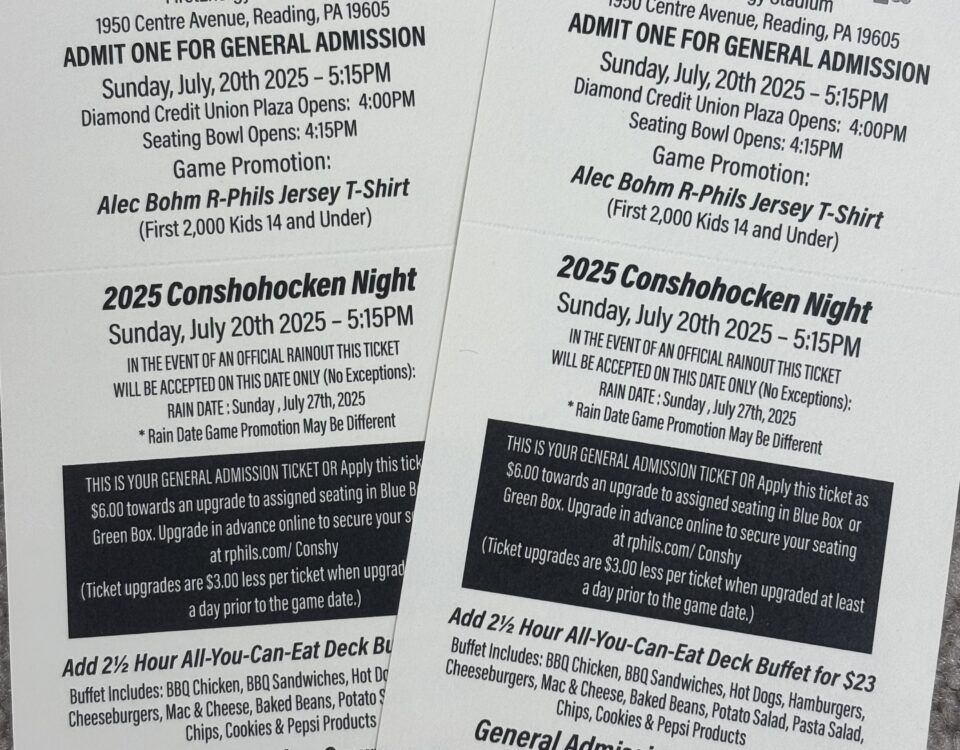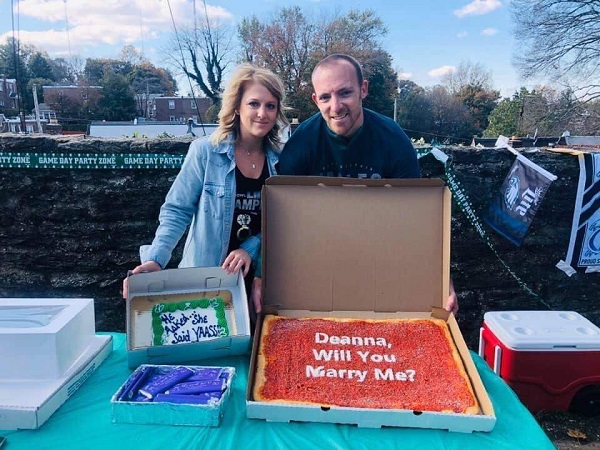
Tomato Pie Proposal – Conshohocken Italian Bakery
November 4, 2019
Harry Street – Who It’s Named After and a Recent Visit by the Family
November 6, 2019We Visited Jim Thorpe Yesterday. What Can Conshohocken Do?

We Visited Jim Thorpe Yesterday. What Can Conshohocken Do?
11/4/2019
by Brian Coll
I love Conshohocken. I have to start with that sentence and I’ll probably end with it.
Having said that, I really enjoyed my afternoon in Jim Thorpe Pa. Our family went up specifically for the train ride through the scenic Lehigh Valley Gorge. Part of the reason we went was I understand the train rides may be coming to a halt. If that is the case, I feel bad for the small businesses and restaurants in the area. The trains were packed yesterday and it seemed as if each ride carried hungry passengers who wandered around the borough in search of a place to try out with family and friends. I know we walked around the quaint borough, checking out the record shop (I’d love to see one in Conshy), a store that had unique jerky, an old 5 & 10 store…. it was great. We really enjoyed our walk through the borough and our drive through neighboring communities. My fear, is if the train does in fact cease operations, what is going to bring the people to this area. They do have a company that provides white water rafting, canoe and tube rides down the river there, I’m sure that helps in the summer months and if anyone is reading this and wants to invest in an idea I have of tube rides from the Conshohocken Brewing Company in Bridgeport to a destination in Conshy or Manyunk let me know….
So…. is there anything that can make Conshohocken a destination? I know the people we have in the community love it here, but is there something that can be done here that could bring people here on the weekends… Maybe somewhere on the river, a unique attraction? Something that could have people visit the Conshohockens. Something that, before or after you did the cool fun thing, you’d want to walk the streets, find a cool place for lunch or dinner. Visit stores like Xtra or Sanctuary Blu. Walk into Flocco’s and buy an Eagles shirt. Hit the Boathouse for some wings or the rooftop at the Pub for a celebration cocktail.
We’d love your ideas and maybe someone with some money and a vision will take us up on our ideas…
Here are some photos from our visit:

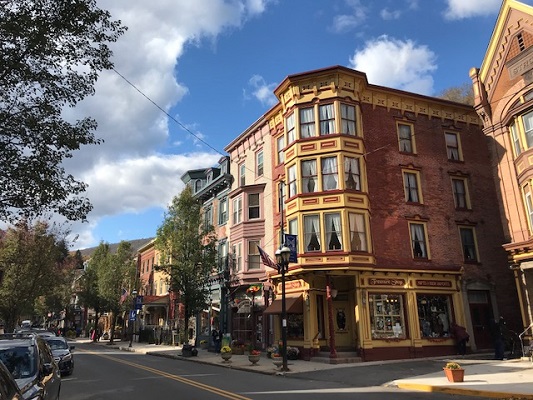

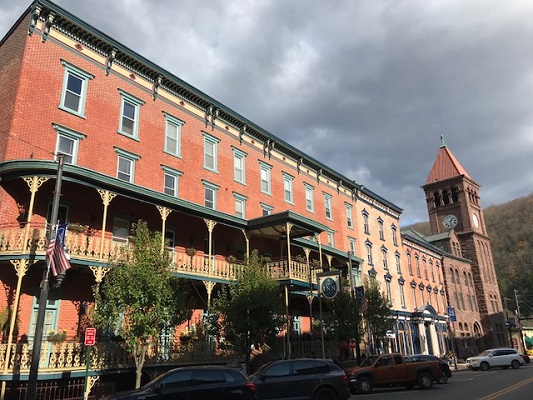
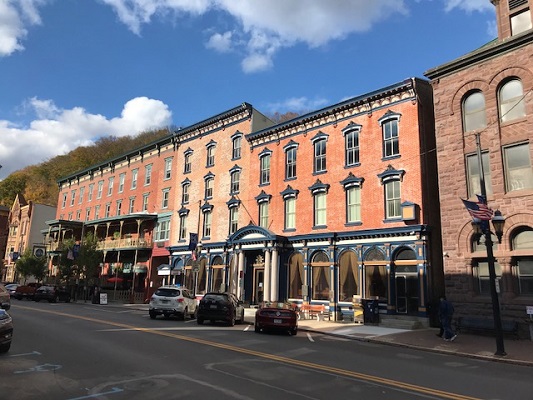
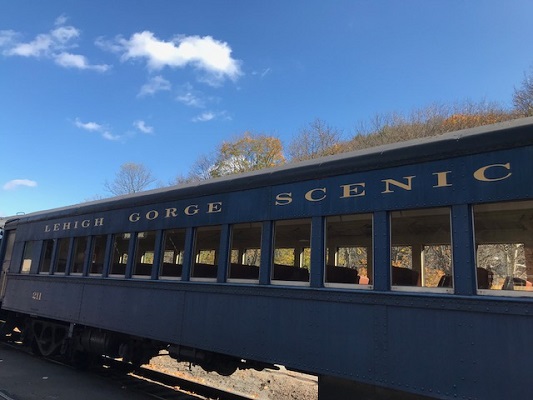
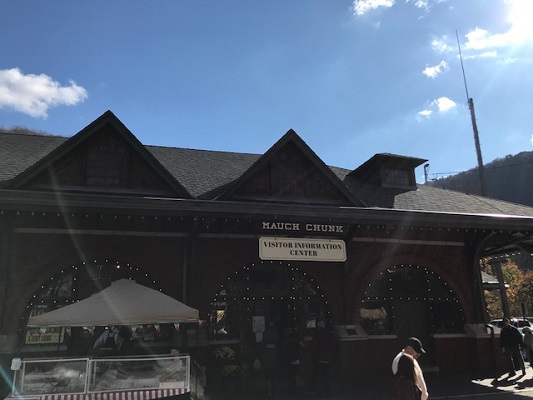
The population is about half of Conshohocken, very scenic though. Here is the history of Jim Thorpe, formerly know as Mauch Chunk. Here is the history of the borough as found on Wikipedia:
History

Central Railroad of New Jersey Station, now a visitors center
Jim Thorpe was founded in 1818 as Mauch Chunk /ˌmɔːk ˈtʃʌŋk/, a name derived from the term Mawsch Unk (Bear Place) in the language of the native Munsee-Lenape Delaware peoples: possibly a reference to Bear Mountain, an extension of Mauch Chunk Ridge that resembled a sleeping bear, or perhaps the original profile of the ridge, which has since been changed heavily by 220 years of mining. The company town was founded by Josiah White and his two partners, founders of the Lehigh Coal & Navigation Company (LC&N). The town would be the lower terminus of a gravity railroad, the Summit Hill & Mauch Chunk Railroad, which would bring coal to the head of the Lehigh Canal for transshipment to the Delaware River, 43 kilometres (26.7 mi) downstream. It would thereby connect LC&N’s coal mines to Philadelphia, Trenton, New York City, and other large cities in New Jersey and Delaware, and by ocean to the whole East Coast.
The town grew slowly in its first decade, then rapidly became larger as a railroad and coal-shipping center. (The other large city with coal mining was Scranton, with a population of over 140,000.) Mauch Chunk is on a flat at the mouth of a right bank tributary (facing downstream) of the Lehigh River at the foot of Mount Pisgah.
The left bank community East Mauch Chunk, which has more of the houses of modern Jim Thorpe, was settled later to support the short-lived Beaver Creek Railroad, the mines which spawned it, and the logging industry. It only came into its growth when the Lehigh Valley Railroad pushed up the valley to oppose LC&N’s effective transportation monopoly over the region, which extended across to northwest Wilkes-Barre at Pittston on the Susquehanna River/Pennsylvania Canal. (See Lehigh and Susquehanna Railroad, a subsidiary of LC&N.)
After the Pennsylvania Canal Commission smoothed the way, LC&N built the Lehigh and Susquehanna Railroad (L&S) from Pittston to Ashley, building the Ashley Planes inclined railway and linked that by rail from Mountain Top to White Haven at the head of the canal’s upper works—referred to as the “Grand Lehigh Canal”—which navigations shortened the Lehigh Gorge (now located in the Lehigh Gorge State Park) route, cutting the distance from Philadelphia to Wilkes-Barre and the Wyoming Valley coal deposits by over 100 miles (160 km). This placed Mauch Chunk in the center of a nexus of transportation in country tough to travel through. When floods wiped out many of the upper Lehigh Canal works in 1861, the L&S Railroad was extended through the gap, and the so-called switchback-twisted backtrack through Avoca, with the improved engines of the day, enabled two-way steam locomotive traction and traffic despite the steep grades. The LC&N headquarters was built across the street from the stylish passenger station that was soon boarding passengers onto trains from New York and Philadelphia to Buffalo.
Mauch Chunk was the location of one of the trials of the Molly Maguires in 1876, which resulted in the hanging of four men found guilty of murder.[8] The population of the borough in 1900 was 4,020; in 1910, it was 3,952.[9]

Jim Thorpe’s grave
Following the 1953 death of renowned athlete and Olympic medal winner Jim Thorpe, Thorpe’s widow and third wife, Patricia, was impatient when, after five months, the planned memorial in Shawnee, Oklahoma had yet to raise the $100,000 to honor him. The town’s citizens had paid for her, a Thorpe son and Jim’s body to be shipped from California, paid and arranged for the funeral service at St. Benedict’s Catholic church, and paid for the mausoleum costs at Fairview Cemetery. Then Gov. Johnston Murray vetoed a bill which would contribute funds to the erection of the memorial at Athletic Park. On Sept. 1st Mrs. Thorpe, saying she feared Jim would be buried in a potter’s field, shipped the body to Tulsa where she said the Chamber of Commerce was going to build a proper memorial, which was not true.[10] When she heard that the boroughs of Mauch Chunk and East Mauch Chunk were desperately seeking to attract business, she made a deal with civic officials. According to Jim Thorpe’s son, Jack, Patricia was motivated by money in seeking the deal.[11] The boroughs merged in 1954[12] and renamed the new municipality in Jim Thorpe’s honor, obtained the athlete’s remains from his wife and erected a monument to the Oklahoma native, who began his sports career 100 miles (161 kilometres) southwest, as a student at the Carlisle Indian Industrial School in Carlisle, Pennsylvania. The monument site contains his tomb, two statues of him in athletic poses, and historical markers describing his life story. The grave rests on mounds of soil from Thorpe’s native Oklahoma and from the Stockholm Olympic Stadium in which he won his Olympic medals.[13]
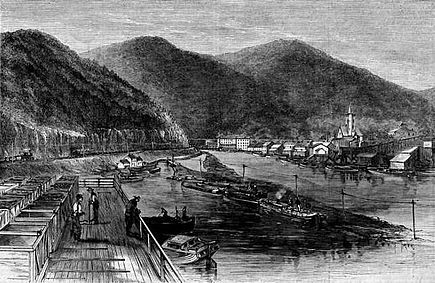
View of Mauch Chunk in 1869
On June 24, 2010, one of Jim Thorpe’s sons, Jack Thorpe, sued the town for his father’s remains, citing the Native American Graves Protection and Repatriation Act, which is designed to return Native American artifacts to their tribal homelands.[14] On February 11, 2011, Judge Richard Caputo ruled that Jack Thorpe could not gain any monetary award, nor any amount for attorney’s fees in the lawsuit and that for the lawsuit to continue other members of the Thorpe family and the Sac and Fox Nation would have to join him as plaintiffs. Before Jack Thorpe could respond to the ruling he died at the age of 73 on February 22, 2011. Because of his death his representatives were given more time to respond to the ruling. On May 2, 2011, William and Richard Thorpe, Jim Thorpe’s remaining sons and the Sac & Fox Nation of Oklahoma joined the lawsuit, allowing it to continue.[15] On April 19, 2013, Federal Judge Richard Caputo ruled in favor of William and Richard Thorpe, ruling that the borough amounts to a museum under the law.[16] This ruling was reversed by the United States Court of Appeals for the Third Circuit on October 23, 2014.[17] The US Supreme Court refused to hear their appeal on October 5, 2015 assuring that Jim Thorpe’s remains will stay in Carbon County.[18]

1915 postcard showing a bird’s eye view of the community
The history of the borough is reflected in the architecture that makes up its many 19th century styles. A former resident and architectural historian, Hans Egli, noted the vast range of styles: Federalist, Greek Revival, Second Empire, Romanesque Revival, Queen Anne, and Richardsonian Romanesque. Most of these architectural examples remained intact beneath aluminum or vinyl siding that has since been removed.
Denise Scott Brown and Robert Venturi, renowned Philadelphia architects, conducted a little-known planning study in the 1970s that attempted to understand the dynamics of historicism and tourism, notions that have come into their own in contemporary times. While Venturi’s planning study was unique at the time, it has since become a critical factor in Jim Thorpe’s rebound as a functioning and economically stable community.[19] Jim Thorpe tourism is based on its vintage architecture, and recreation such as hiking, paintball and white water rafting.
The Carbon County Section of the Lehigh Canal, Old Mauch Chunk Historic District, Mauch Chunk Switchback Railway, Asa Packer Mansion, Harry Packer Mansion, Carbon County Jail, Central Railroad of New Jersey Station, and St. Mark’s Episcopal Church are listed on the National Register of Historic Places.[20]
And…. if you’ve read this to the end, I love Conshohocken. Thank you for reading, and please, if you have cool ideas about what could be a cool attraction here in the Conshohockens let us know.

